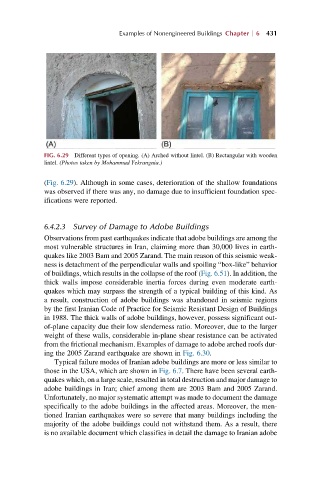Page 488 - Advanced Design Examples of Seismic Retrofit of Structures
P. 488
Examples of Nonengineered Buildings Chapter 6 431
FIG. 6.29 Different types of opening. (A) Arched without lintel. (B) Rectangular with wooden
lintel. (Photos taken by Mohammad Yekrangnia.)
(Fig. 6.29). Although in some cases, deterioration of the shallow foundations
was observed if there was any, no damage due to insufficient foundation spec-
ifications were reported.
6.4.2.3 Survey of Damage to Adobe Buildings
Observations from past earthquakes indicate that adobe buildings are among the
most vulnerable structures in Iran, claiming more than 30,000 lives in earth-
quakes like 2003 Bam and 2005 Zarand. The main reason of this seismic weak-
ness is detachment of the perpendicular walls and spoiling “box-like” behavior
of buildings, which results in the collapse of the roof (Fig. 6.51). In addition, the
thick walls impose considerable inertia forces during even moderate earth-
quakes which may surpass the strength of a typical building of this kind. As
a result, construction of adobe buildings was abandoned in seismic regions
by the first Iranian Code of Practice for Seismic Resistant Design of Buildings
in 1988. The thick walls of adobe buildings, however, possess significant out-
of-plane capacity due their low slenderness ratio. Moreover, due to the larger
weight of these walls, considerable in-plane shear resistance can be activated
from the frictional mechanism. Examples of damage to adobe arched roofs dur-
ing the 2005 Zarand earthquake are shown in Fig. 6.30.
Typical failure modes of Iranian adobe buildings are more or less similar to
those in the USA, which are shown in Fig. 6.7. There have been several earth-
quakes which, on a large scale, resulted in total destruction and major damage to
adobe buildings in Iran; chief among them are 2003 Bam and 2005 Zarand.
Unfortunately, no major systematic attempt was made to document the damage
specifically to the adobe buildings in the affected areas. Moreover, the men-
tioned Iranian earthquakes were so severe that many buildings including the
majority of the adobe buildings could not withstand them. As a result, there
is no available document which classifies in detail the damage to Iranian adobe

